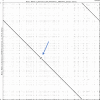Complete hybrid genome assembly of clinical multidrug-resistant Bacteroides fragilis isolates enables comprehensive identification of antimicrobial-resistance genes and plasmids
- PMID: 31697231
- PMCID: PMC6927303
- DOI: 10.1099/mgen.0.000312
Complete hybrid genome assembly of clinical multidrug-resistant Bacteroides fragilis isolates enables comprehensive identification of antimicrobial-resistance genes and plasmids
Abstract
Bacteroides fragilis constitutes a significant part of the normal human gut microbiota and can also act as an opportunistic pathogen. Antimicrobial resistance (AMR) and the prevalence of AMR genes are increasing, and prediction of antimicrobial susceptibility based on sequence information could support targeted antimicrobial therapy in a clinical setting. Complete identification of insertion sequence (IS) elements carrying promoter sequences upstream of resistance genes is necessary for prediction of AMR. However, de novo assemblies from short reads alone are often fractured due to repeat regions and the presence of multiple copies of identical IS elements. Identification of plasmids in clinical isolates can aid in the surveillance of the dissemination of AMR, and comprehensive sequence databases support microbiome and metagenomic studies. We tested several short-read, hybrid and long-lead assembly pipelines by assembling the type strain B. fragilis CCUG4856T (=ATCC25285=NCTC9343) with Illumina short reads and long reads generated by Oxford Nanopore Technologies (ONT) MinION sequencing. Hybrid assembly with Unicycler, using quality filtered Illumina reads and Filtlong filtered and Canu-corrected ONT reads, produced the assembly of highest quality. This approach was then applied to six clinical multidrug-resistant B. fragilis isolates and, with minimal manual finishing of chromosomal assemblies of three isolates, complete, circular assemblies of all isolates were produced. Eleven circular, putative plasmids were identified in the six assemblies, of which only three corresponded to a known cultured Bacteroides plasmid. Complete IS elements could be identified upstream of AMR genes; however, there was not complete correlation between the absence of IS elements and antimicrobial susceptibility. As our knowledge on factors that increase expression of resistance genes in the absence of IS elements is limited, further research is needed prior to implementing AMR prediction for B. fragilis from whole-genome sequencing.
Keywords: Bacteroides fragilis; Oxford Nanopore; antimicrobial resistance; genome sequencing; hybrid assembly; insertion sequences; plasmid.
Conflict of interest statement
The authors declare that there are no conflicts of interest
Figures



References
-
- Nagy E, Urbán E, Nord CE, on behalf of ESCMID Study Group on Antimicrobial Resistance in Anaerobic Bacteria Antimicrobial susceptibility of Bacteroides fragilis group isolates in Europe: 20 years of experience. Clin Microbiol Infect. 2011;17:371–379. doi: 10.1111/j.1469-0691.2010.03256.x. - DOI - PubMed
Publication types
MeSH terms
LinkOut - more resources
Full Text Sources
Molecular Biology Databases
Research Materials

